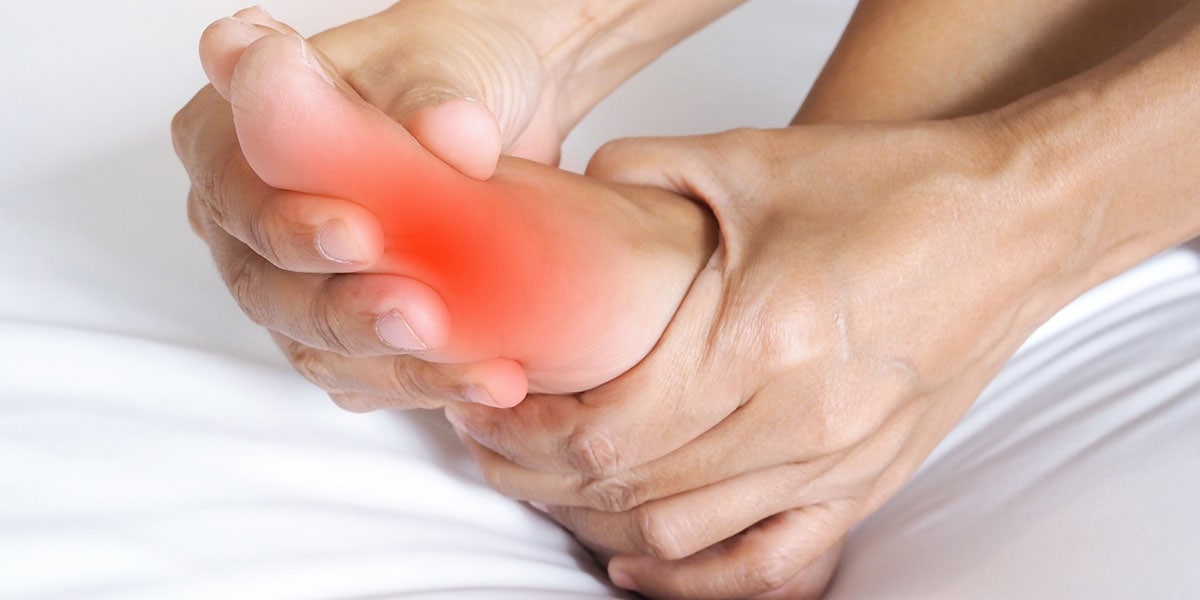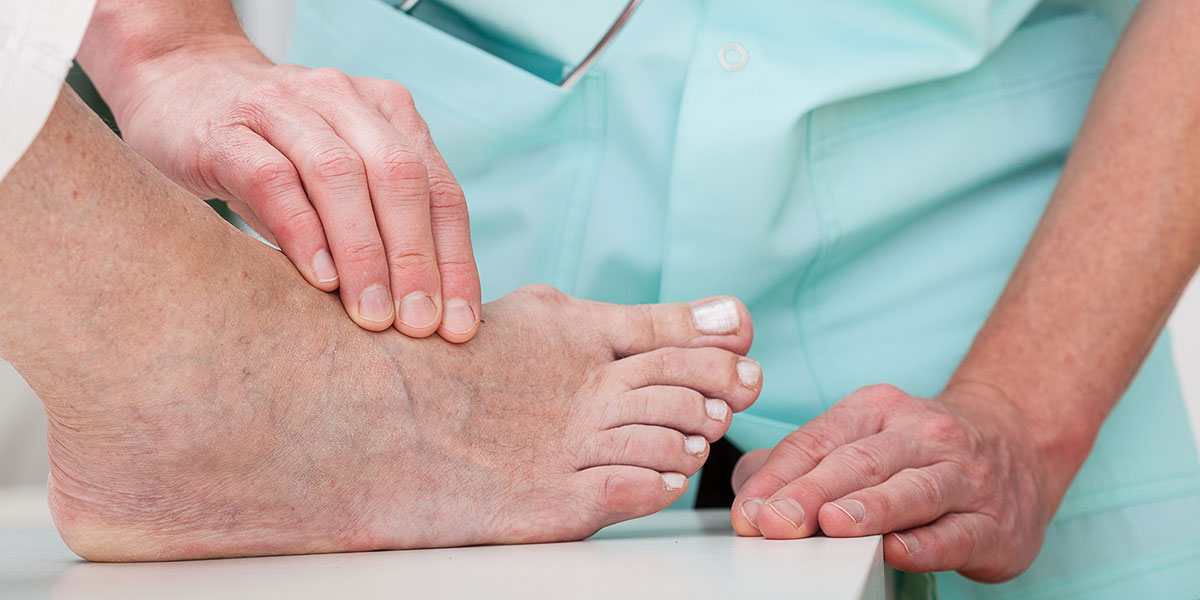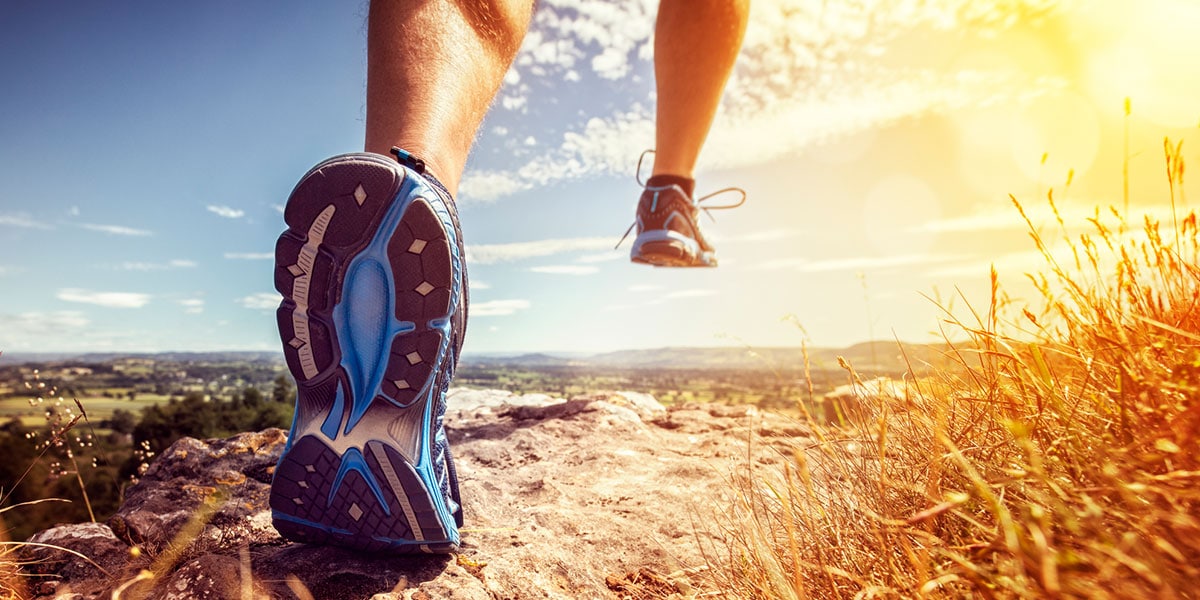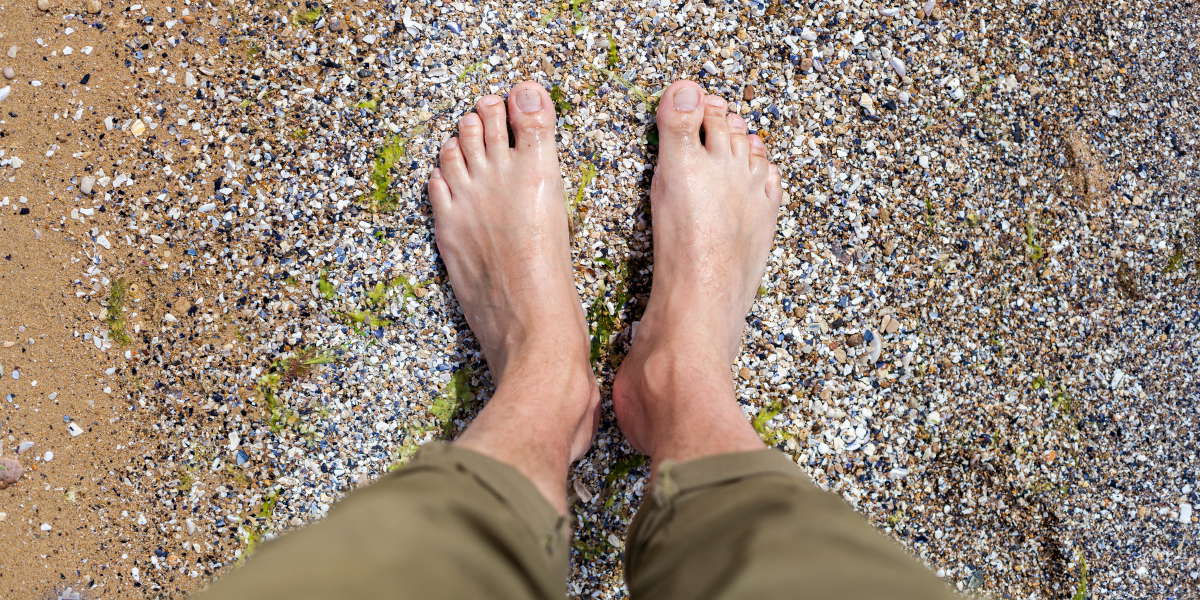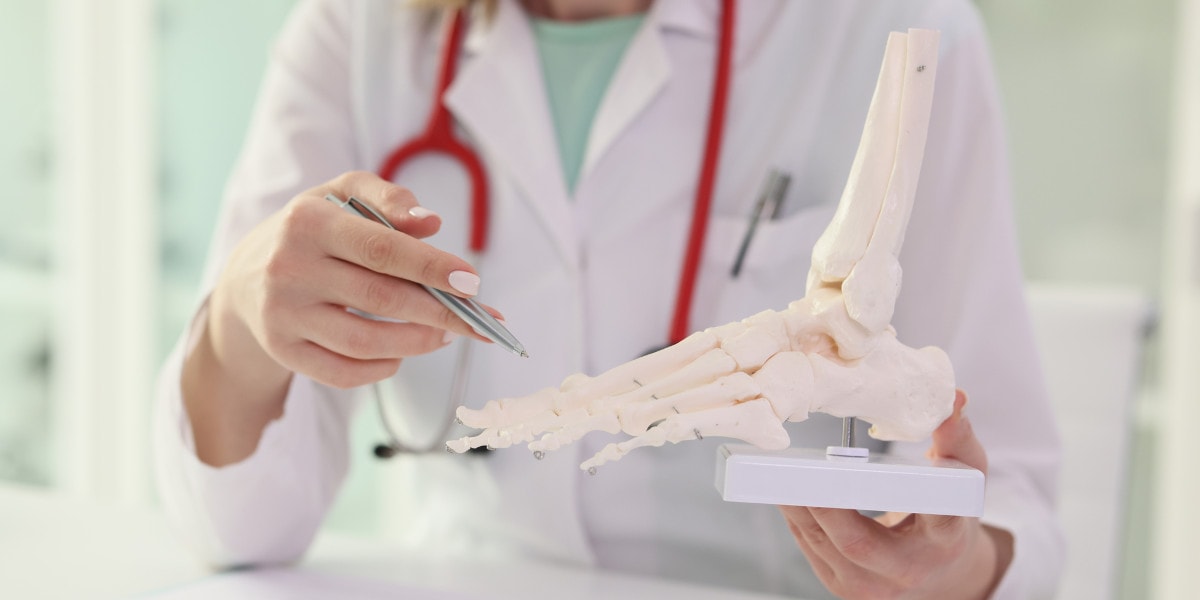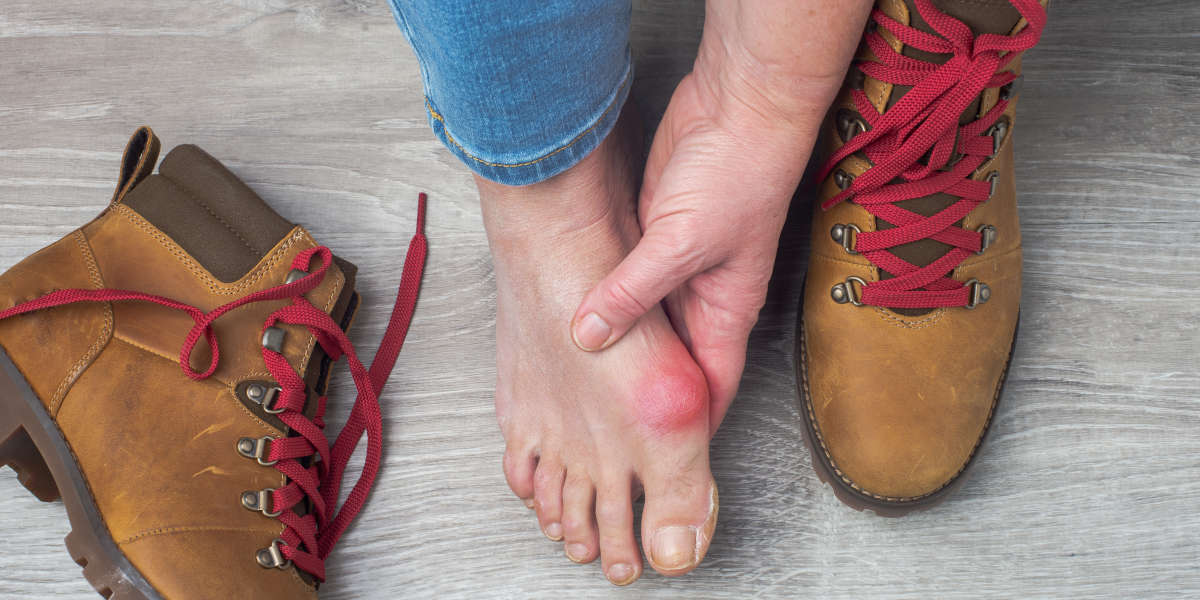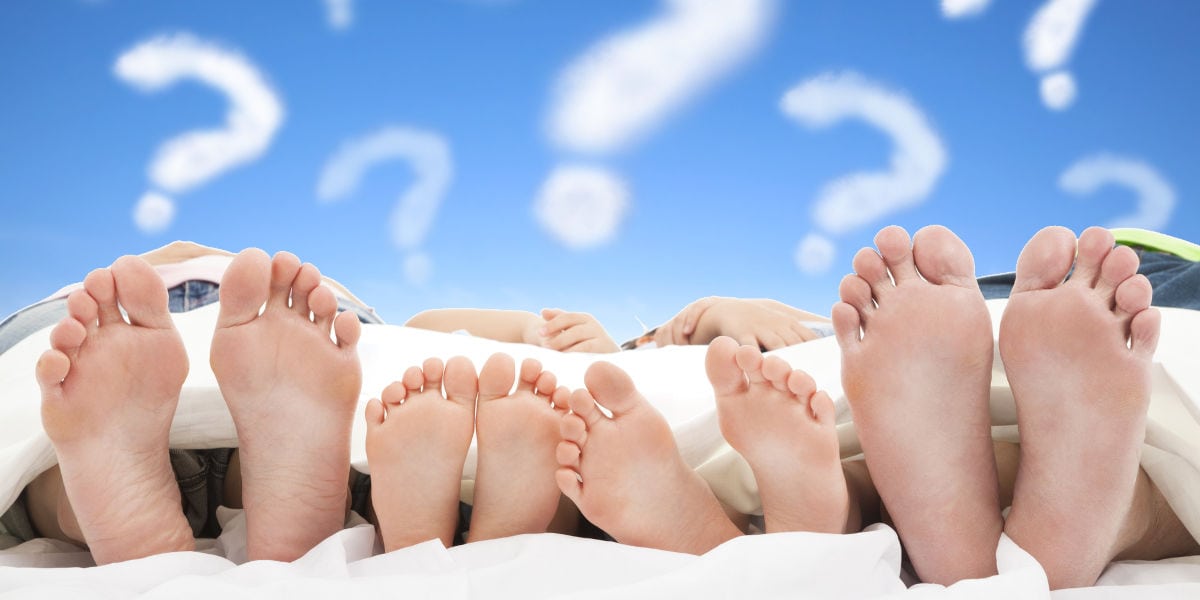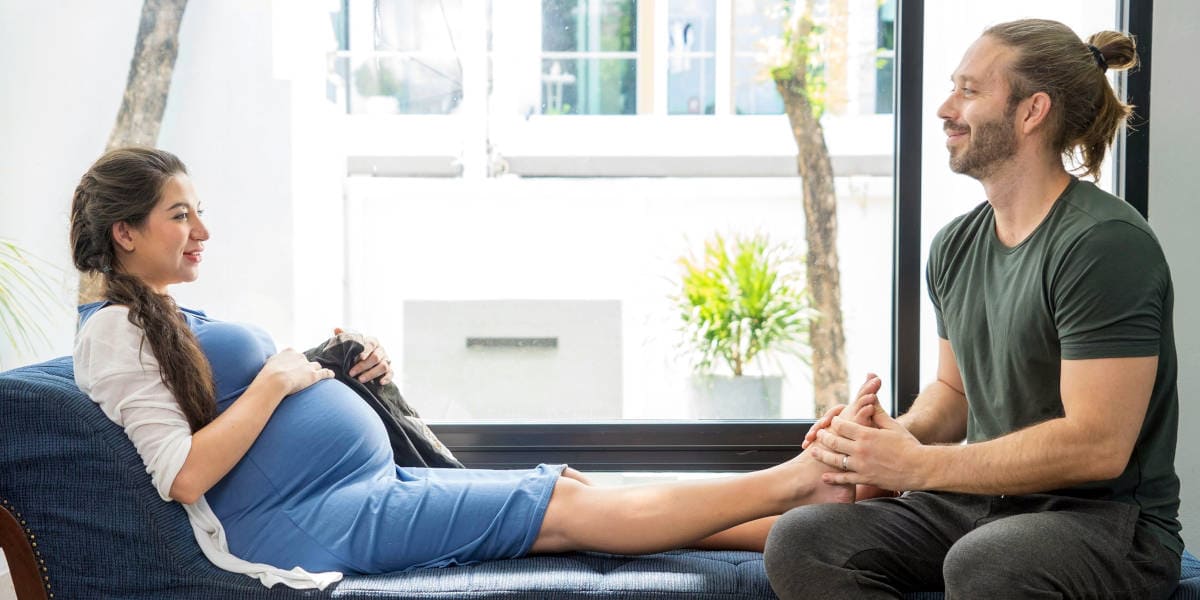There are a lot of questions our patients have about bunions and their treatment options. We’ve collected some of the most popular ones below.
Don’t see an answer to your question? Let us know here and we’ll try to add it!
Bunion Pathology FAQs
-
Can bunions cause other aches and pains?
Studies have shown that people with bunions tend to have higher incidence of other types of pain as well, including in the foot, knee, hip, and lower back.
-
Do bunions run in the family?
A bunion itself isn’t hereditary, meaning that if you have a bunion, you won’t pass it on to your kids the way you might pass on your eye color. However, the particular mechanical structures which make a person more prone to bunions, can be inherited. If your relatives have bunions, there’s a good chance that you and your kids are prone to them as well.
-
I have a bony bump on my pinky toe. Is that also a bunion?
Yes. This type of bunion is called Tailor’s bunion, or a bunionette, and it’s less common than big toe bunions. Tailor’s bunion affects the fifth metatarsal bone and the pinky toe joint. The structural causes and painful symptoms of Tailor’s bunion are similar to most other bunions.
-
Why are Bunions Painful?
Bunion pain often occurs when the bunion is stuffed into a shoe. As the bones deviate, the bump will protrude to a greater and greater extent. A particular nerve – the medial dorsal cutaneous nerve, for the curious – runs over the bump, into the foot, and up the leg. When you put on a shoe, the bunion presses on the nerve and associated soft tissue, causing pain. The larger the bump, the more pressure it will put on this area. And because the big toe joint carries much of your weight while walking and standing, spending long periods of time on your feet can also aggravate bunion symptoms.
-
What is a Bunion?
Bunions are common structural deformities that affect the big toe joint. The slender bone that leads to the big toe, called the first metatarsal, deviates toward the center-line of the body. This pushes the head of the metatarsal outward, forming a bony and soft tissue protrusion on the inside of the foot. This deviation tips the base of the big toe bone and the big toe itself toward the lesser toes.
Bunion Surgery FAQs
-
What Surgical Hardware is Used During a Lapidus Bunionectomy?
At University Foot and Ankle Institute we use a new staple and plate system from Crossroads that is stronger and better than the regular screw and plate system. We place 2 staples and a plate with 2 screws.
-
Will bunion surgery be painful?
Typically, our minimally-invasive surgical techniques allow for a relatively pain-free recovery. Most of the time, our patients require only over-the-counter pain relievers and anti-inflammatories. UFAI is proud to stand at the forefront of research on pain control following bunion surgery. Our long-acting local anesthetics control pain throughout your recovery.
-
Will I be able to return to my normal sports and activities after bunion surgery?
Yes, after you’re fully rehabilitated. The length of your recovery period depends upon the severity of your bunion and the type of bunion surgery you’ve received. At UFAI, it’s our goal to eliminate pain and restore normal foot functioning, so you can confidently return to the activities you love after surgery.
-
Will I have a scar from bunion surgery?
Our minimally-invasive techniques minimize the appearance of scars or, in some cases, make them invisible when our patient is fully healed. You can also reduce scarring by applying silicone gel sheets, vitamin E cream, and/or Mederma.
-
What kind of anesthesia will I be under during the procedure?
Our bunion surgeons prefer a mild IV sedation, as opposed to general anesthesia. This helps to keep you calm and immobile, without the physical stress of total unconsciousness.
-
Can you perform bunion correction surgery on both feet at the same time?
It’s possible to do both at the same time, but our surgeons prefer to space it out by at least two weeks. This allows for partial recovery from the first foot, so that we can assess the effectiveness of the surgery before we try the second foot.
-
How invasive is bunion correction surgery?
Our bunion specialists at have developed minimally-invasive techniques that address the bony protrusion as well as correcting the underlying structural issue causing your bunion. Our techniques allow for immediate weight-bearing, virtually painless recovery, and no scarring. Best of all, your bunion will be gone for good.
-
Can you remove the bunion just by shaving down the bone?
Absolutely not. We strongly discourage patients from seeking treatment from a surgeon who claims otherwise. A bunion is not just a bony bump. The bony bump is only one component of a complicated structural issue. A bunion is actually caused by a misaligned bone, the first metatarsal. If your surgeon merely shaves off the bony bump, and doesn’t re-align the bone, then the bump will almost certainly come back. We know this because correcting previous bunion surgeries comprises roughly 25% of our practice.
-
Will my bunion return after surgery?
Our bunionectomy techniques are very effective in removing the bunion and providing relief from pain and discomfort. However, it’s up to you to modify your behavior to ensure that your bunion does not return.
Some patients find it hard to give up high heels, pointy-toed shoes, and other problematic footwear. If you make use of custom orthotics, and practice good foot care, you should expect a permanent recovery after bunion surgery. -
Do I need bunion surgery?
Most bunions – particularly bunions in their early stages – can be treated without surgery. If there are less-invasive treatments available to you, UFAI doctors will most often prefer that route. We like to avoid surgery whenever possible, as surgery can be risky and costly. Remember that bunions are progressive deformities that get worse over time so starting treatment early is best.
-
I’m having bunion surgery out-of-state. When can I return home?
The minimum post-op stay is 5 days, but we ask that you stay in town for 10 days, if possible. We want to keep an eye on your recovery and the best way to do that is with early follow-up visits.
-
How should I care for my foot following bunionectomy?
You’ll need to keep your stitches and bandages dry and clean for 1-3 weeks, until the stitches can be removed. When showering or bathing, keep your foot away from the water as much as you can. You can keep it covered with a plastic bag. Elevate your foot while sitting and laying down. Use over-the-counter pain relievers (NSAIDs) to ease discomfort and inflammation. If your doctor recommended physical therapy, practice your exercises regularly. This will help speed the recovery process and restore normal foot function and mobility.
-
What will bunion surgery recovery be like?
Typically, our minimally-invasive surgical techniques allow for a relatively pain-free recovery. Most of the time, our patients require only over-the-counter pain relievers and anti-inflammatories. We are proud to stand at the forefront of research on pain control following bunion surgery. Our long-acting local anesthetics control pain throughout your recovery. Additionally, you will most likely be able to bear weight immediately post-op, with the help of a walking boot and crutches. Most patients can walk without crutches after a few days.
In severe cases, you will need to stay off the foot for 2-3 weeks after recovery. This is a remarkable improvement on our competitors’ recovery time of 6-8 weeks. Your surgeon will talk with you about when you can resume your normal routine.
Bunion Surgery Recovery FAQs
-
Will bunion surgery be painful?
Typically, our minimally-invasive surgical techniques allow for a relatively pain-free recovery. Most of the time, our patients require only over-the-counter pain relievers and anti-inflammatories. UFAI is proud to stand at the forefront of research on pain control following bunion surgery. Our long-acting local anesthetics control pain throughout your recovery.
-
Will I be able to return to my normal sports and activities after bunion surgery?
Yes, after you’re fully rehabilitated. The length of your recovery period depends upon the severity of your bunion and the type of bunion surgery you’ve received. At UFAI, it’s our goal to eliminate pain and restore normal foot functioning, so you can confidently return to the activities you love after surgery.
-
When will I be able to wear my regular shoes?
It depends on the type of surgery and the severity of your bunion. You should be able to wear normal shoes in about 4-6 weeks. That said, it is up to the patient to make good footwear choices post-surgery. Certain shoes, especially high heels and pointy-toes, tend to exacerbate the conditions that create a bunion. If you go back to wearing these shoes after your surgery, there’s a chance your bunion will come back. It’s best to wear comfortable shoes that support your arches and leave plenty of room in the toe box. Ask your bunion specialist about custom orthotic inserts that can accommodate the bunion-prone foot.
-
I’m having bunion surgery out-of-state. When can I return home?
The minimum post-op stay is 5 days, but we ask that you stay in town for 10 days, if possible. We want to keep an eye on your recovery and the best way to do that is with early follow-up visits.
-
How should I care for my foot following bunionectomy?
You’ll need to keep your stitches and bandages dry and clean for 1-3 weeks, until the stitches can be removed. When showering or bathing, keep your foot away from the water as much as you can. You can keep it covered with a plastic bag. Elevate your foot while sitting and laying down. Use over-the-counter pain relievers (NSAIDs) to ease discomfort and inflammation. If your doctor recommended physical therapy, practice your exercises regularly. This will help speed the recovery process and restore normal foot function and mobility.
-
What will bunion surgery recovery be like?
Typically, our minimally-invasive surgical techniques allow for a relatively pain-free recovery. Most of the time, our patients require only over-the-counter pain relievers and anti-inflammatories. UFAI is proud to stand at the forefront of research on pain control following bunion surgery. Our long-acting local anesthetics control pain throughout your recovery. Additionally, you will most likely be able to bear weight immediately post-op, with the help of a walking boot and crutches. Most patients can walk without crutches after a few days. In severe cases, you will need to stay off the foot for 2-3 weeks after recovery. This is a remarkable improvement on our competitors’ recovery time of 6-8 weeks. Your UFAI doctor will talk with you about when you can resume your normal routine.
Bunions and Shoes FAQs
-
What Are Some Tips for Shoe Shopping with Bunions?
As you move through your day, your feet tend to swell. Do your shopping near the end of the day to make sure you don’t buy anything that will be too tight in the morning.
- Try on your footwear using the socks you plan on wearing with them.
- Have your feet professionally measured by staff at the shoe store. You might want to try a half-size up from your normal size.
- Leave one-half inch of space for your toes to wiggle.
Take several laps around the store wearing the shoes. Make sure the backs of the shoes aren’t rubbing against your heel while you walk.
-
What About Flip-Flops and Bunions?
Flip-flops may seem like a good choice for accommodating a bunion, but we strongly recommend against them. While walking in flip-flops, your adductor hallucis muscles need to work extra hard in order to keep the shoes on your feet, which can exacerbate the bunion. Additionally, the toe partition shoves the base of the big toe further away from the lesser toes, contributing to the deformity.
-
What About High-Heels and Bunions?
Avoid high-heels. If you desire a high-heel for special occasions, make sure the heel is no taller than 2 inches, and leave room for your toes to fit comfortably.
-
Do I Need to Buy New Shoes?
If you are on a budget, you might not be able to splurge on new shoes. Instead, you can modify your old footwear to meet your new needs. There are two ways you can do this. Find a shop with a shoe stretcher. A stretcher can widen the toes of your shoes, making them more comfortable. Use orthotic inserts. You can pick up a set over the counter, or visit your foot and ankle specialist to get fitted for a custom set.
-
Where Can I Find Appropriate Shoes That Support Bunions?
Almost any shoe store will sell comfortable shoes with enough room in the toe box to accommodate a bunion. We recommend the selections at FootSmart, OrthoFeet, and The Walking Company. You can also find extra-depth shoes on the web. If you’re not sure where to go, ask your foot and ankle specialist. You can also order custom-fitted shoes from an orthotist.
-
What Kind of Shoes Should I Wear If I Have a Bunion?
When you have a bunion, you need to prioritize function over fashion. This doesn’t mean your shoes have to be ugly, but you might need to avoid certain styles to ensure your comfort and keep the bunion from getting worse. Choose a well-fitting shoe with a padded sole, and a generous toe box that doesn’t press too hard on the bunion. Sometimes, all you need to do is go up a half a size. Look for a shoe with about one-quarter to one-half inch of added depth to leave space for any corns or calluses that may have developed on the bottom of your foot. You can also use that additional space for a custom orthotic insert.
-
How Does a Bunion Impact My Choice of Footwear?
A bunion is a progressive deformity that changes the shape of your foot, making it more and more difficult to wear your normal shoes. If you try to squeeze your way into inappropriate shoes, the bony bump on the inside of your foot will push against the interior wall, putting pressure on a particular nerve and frequently inflaming the bony prominence and big toe joint. The pain can be debilitating, and it can change your gait unconsciously, putting you at risk for further injuries. However, choosing the right shoes can alleviate pain and help you return to your normal activities.
Cost and Insurance FAQs
-
Will My Insurance Cover Bunion Surgery?
The general answer is yes! A bunion is a medical condition that affects your health, quality of life, and ability to work and function. Most insurance plans do cover bunion surgery, but you need to check with your carrier to find out for sure. Find out from your insurer if your bunion surgeon is in-network or out-of-network. Bunion surgery out-of-network can cost you more out of pocket. Ask your insurer about your co-payment and whether you’ve already met your deductible for the year. These factors will contribute to your coverage.
-
What Other Factors Contribute to the Price of My Surgery?
What happens when you go under the knife can also play a role in cost. For example, general anesthesia will be more expensive than sedation or localized numbing. Your anesthesiologist may be in- or out-of-network with your insurance carrier. Your personal health can impact the cost of surgery as well. Pre-existing health problems can complicate the surgery. Additionally, if an emergency occurred during the procedure, you might incur additional costs.
-
How Much Does Bunion Surgery Cost?
There are over 40 different types of bunion surgery in use in the U.S., which means that the costs can vary widely. According to our research, we’ve found that the median price tag hovers around $5,560, but it can range from $3,500 to over $12,000. The type of procedure performed can also alter the cost of the procedure. Larger bunions require larger correction and therefore may require more surgical hardware, which can increase the cost. Geography plays an influential role in determining health care costs. The surgeons and types of hospitals or surgical centers available to you depend largely upon where you live. Urban dwellers tend to have more options than rural residents, and may be able to shop around for a better price.
Non-Surgical FAQs
-
Can a bunion be prevented or reversed without surgery?
No. Bunions are progressive foot deformities that will only get worse with time. Orthotics and splints can change the positioning of the foot, aid foot functioning, and relieve pain, but they cannot reverse or stop a developing bunion. The only way to permanently correct a bunion is through surgery. However, you can significantly slow the progress of a bunion and manage symptoms with conservative treatments at home. With due diligence, most bunions patients won’t need any surgery at all. Your doctor will want to periodically check on the progress of your bunion with a physical exam and an x-ray. If conservative measures have failed to work, and pain is starting to interfere with your daily activities, then it’s time to discuss surgical options with your doctor.
-
What steps can I take at home to ease bunion pain?
Bunion pain arises from the pressure created between the bony bump on the inside of your foot and the shoes that you wear. For starters, you can use anti-inflammatory medication, like aspirin, ibuprofen, and naproxen to manage pain and swelling. Icing the area for 10-15 minute intervals can provide relief as well. At the end of the day, soak your feet in a soothing, hot bath.
-
How can I modify my shoes to accommodate my bunion?
Choose shoes that leave plenty of room for your toes to wiggle. Avoid narrow shoes and shoes with pointy toes. Some shoes, such as those made from leather or canvas, can be stretched with a shoe stretcher to allow enough room for your bunion. You can also use orthotic inserts to relieve the pressure from the joint. Try cushioning the bony area with gel pads or moleskin to prevent friction. Avoid thick or tight socks.
-
How can orthotics and splints help with bunions?
Even though orthotics and splints can’t reverse bunions, they can certainly help relieve pain and improve foot functioning. Toe spacers and night splints hold your toe in place, taking pressure off the joint and slowing the progress of your bunion. Most patients find them to be effective in pain relief.
-
Can physical therapy play a role in bunion treatment?
Yes. At UFAI, our physical therapists can design you an individualized stretching and exercise plan based on your condition. For example, you can grab your big toe and pull it into proper alignment for 10-15 seconds at a time. Visit the experts at UFAI for a personalized recommendation.
Other Bunion FAQs
-
Will I be able to wear high heels after bunion correction surgery?
It is up to the patient to make good footwear choices post-surgery. Certain shoes, especially high heels and pointy-toes, tend to exacerbate the conditions that create a bunion. If you go back to wearing these shoes after your surgery, there’s a chance your bunion will come back so it’s best to wear comfortable shoes that support your arches and leave plenty of room in the toe box.
-
Will I set off metal detectors at the airport after my surgery?
The types of hardware used in bunion surgery are usually too small to set off airport metal detectors. They may set off particularly sensitive detectors. Inform security agents of the screws in your foot. They may use a handheld scanner to check you. There is no requirement to provide written documentation of your surgical hardware
-
Can children be diagnosed with a bunion?
A bunion can be diagnosed in a patient as young as 3 r 4 years old. However, bunion surgery isn’t recommended until the child’s growth plates has closed, around the age of 13 or 14. Non-invasive treatments are usually exhausted before resorting to surgery. On children, the most common bunion surgery is the Lapidus Bunionectomy.
-
Can’t you just shave the bunion off?
No, and we would strongly discourage patients from seeking treatment from a surgeon who claims otherwise. A bunion is not just a bony bump. The bony bump is only one component of a complicated structural issue. A bunion is actually caused by a misaligned bone, the first metatarsal. If your surgeon merely shaves off the bony bump, and doesn’t re-align the bone, then the bump will almost certainly come back. We know this because correcting previous bunion surgeries comprises roughly 30% of our practice.
Physical Therapy FAQs
-
What is gait training?
Gait training is a type of physical therapy that focuses specifically on walking. In gait training, you will work on strengthening your big toe and improving its flexibility. You’ll also learn how to push off of your big toe properly to avoid further injury. Your physical therapist will recommend an at-home training schedule between visits to the clinic.
-
My protective boot will be removed soon. How can physical therapy help me return to normal functioning?
About 3-4 weeks after surgery, you will no longer need to wear your protective shoe. You will continue to meet with your physical therapist for another 4-6 weeks. The initial focus will be on reducing pain and swelling. Your physical therapist will teach you some mild range-of-motion exercises and techniques for self-massage. Continue to use ice and elevation as needed. Next, your physical therapist will begin gait training. You should practice your exercises at home daily, in addition to the practice you receive in the clinic.
-
I’ve just received bunion surgery. What role will physical therapy play in my post-op rehabilitation?
Although each individual’s road to recovery is different, most patients will be in a protective shoe or boot for about 4 weeks after bunion surgery. Your rehabilitation may take longer or shorter depending on the severity of your bunion and the type of surgery you had. During your time in the boot, you’ll need to keep pressure off your foot to allow the bones to heal in place. A physical therapist will teach you how to use a cane, walker, or crutches. Your therapist will also instruct you on using ice, elevation, and medication to control pain and reduce swelling.
-
What is activity training?
As you make improvements in your strength and flexibility, your physical therapist will add in exercises to help you return to your normal activities, such as those related to your job, sports, or hobbies.
-
What kinds of orthotics and other assistive devices can help manage bunion symptoms?
Depending on your condition, your physical therapist may recommend: Splints and toe separators. These can keep the toes in alignment and relieve pressure from the big toe. Custom arch supports. These help to balance and support the foot and ankle while walking. A cane, a walker, or crutches. These devices support your weight and take the pressure off your bunion, allowing you to walk without pain.
-
What can my physical therapist teach me about managing bunion symptoms?
Your physical therapist will teach you how to use periodic foot elevation, self-massage, and alternate icing and heating to keep inflammation and pain to a minimum. You can also learn how to apply therapeutic compression tape to improve the alignment of the big toe and relieve pain.
-
What is balance training?
The pain and positioning of a bunion can destabilize your body while in motion, putting you at risk for injury. In balance training, your physical therapist will teach you exercises to use while standing or walking to improve your balance and reduce the risk of falling.
-
How can exercise help my bunion?
Your physical therapist will design a customized exercise program to suit your needs, with a focus on improving your gait and the alignment of the big toe while standing. Your program will include a variety of stretches, range-of-motion, and strengthening exercises.
-
What is manual therapy?
Your physical therapist will use hands-on techniques to gently manipulate the ankle and big toe. Manual therapy improves the position of the big toe and increases its range of motion.
-
Can bunions be treated with physical therapy?
Yes. Most bunions can be treated non-invasively, and physical therapy in particular plays an important role in managing bunion symptoms. Physical therapy can help to reduce pain, improve muscle strength, and straighten the big toe to a more functional angle. Physical therapy for bunion treatment typically includes manual therapy, exercise, balance training, symptom management, activity training, and the use of orthotics and assistive devices.



